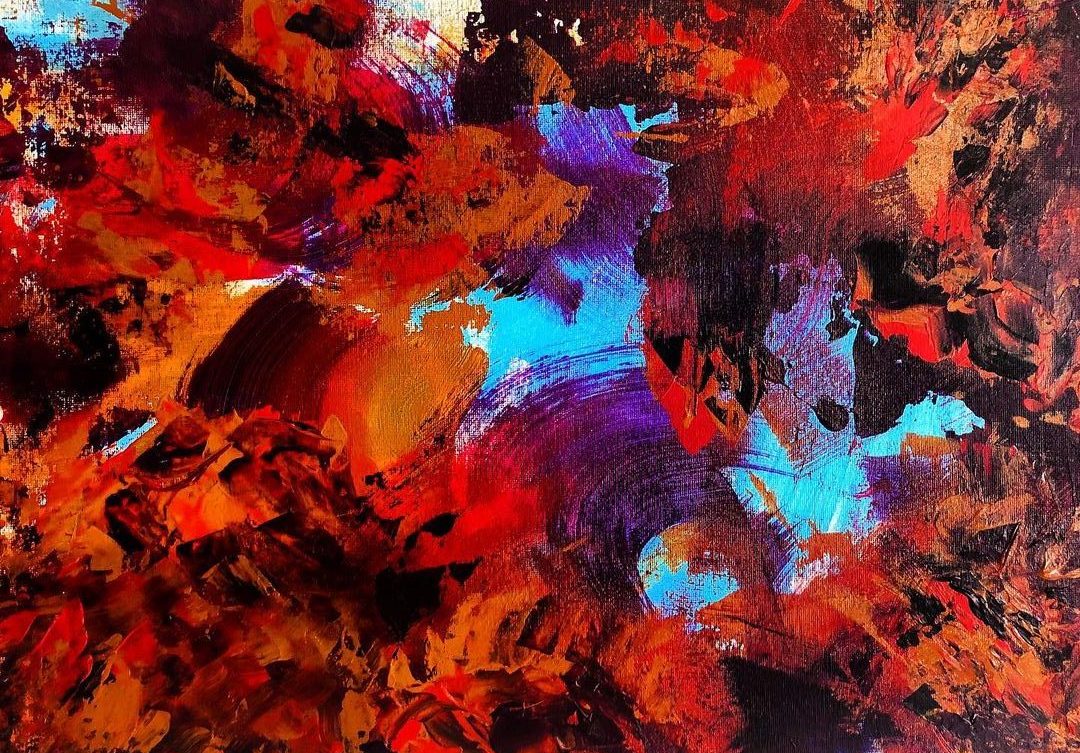
Stories
Bright Futures: Visually Impaired Artists
Art is for everyone – including people with a visual impairment. In fact, some of the most amazing artworks are created by visually impaired artists, who use their unique perspectives to create beautiful pieces that challenge perceptions around art and visual impairment.
That’s why we’re so excited to present this blog as part of our Bright Futures series, which aims to showcase different career paths that visually impaired people can take and inspire you to think creatively about your future!
In this post, we will feature the work of three visually impaired artists and share their advice for young people interested in pursuing art, including two artist profiles and a guest feature from Kimberley Burrows, who has written a guide especially for Useful Vision about starting your own creative journey. Through their stories, we hope to inspire a new generation of visually impaired artists and highlight the incredible contributions they make to the world of art.
Artist Profile – Joey Hernandez
Award-winning California-based artist, Joey Hernandez (@JoeyHernandezArt), was in high school when she began to lose her vision. Like many people, she didn’t know much about sight loss beyond the inaccurate stereotypes presented in pop culture. As her vision deteriorated over the course of a few months, Joey realised that blindness exists on a spectrum, and that visually impaired people can live full, art-filled lives.
However, this realisation was accompanied by frustration. Joey struggled to find images that represented how she saw the world and felt that her experiences were not accurately portrayed in the media. One aspect of her vision that particularly stood out to her was the constant presence of moving neon dots. This phenomenon, which Joey calls her ‘lights’, inspired her to try painting. ‘I initially started painting after my vision began to change’ she told Useful Vision. ‘I wanted to find a way to show how the sparkling dots I see in my centre field of vision look.’ She picked up a brush and began to explore using acrylics.
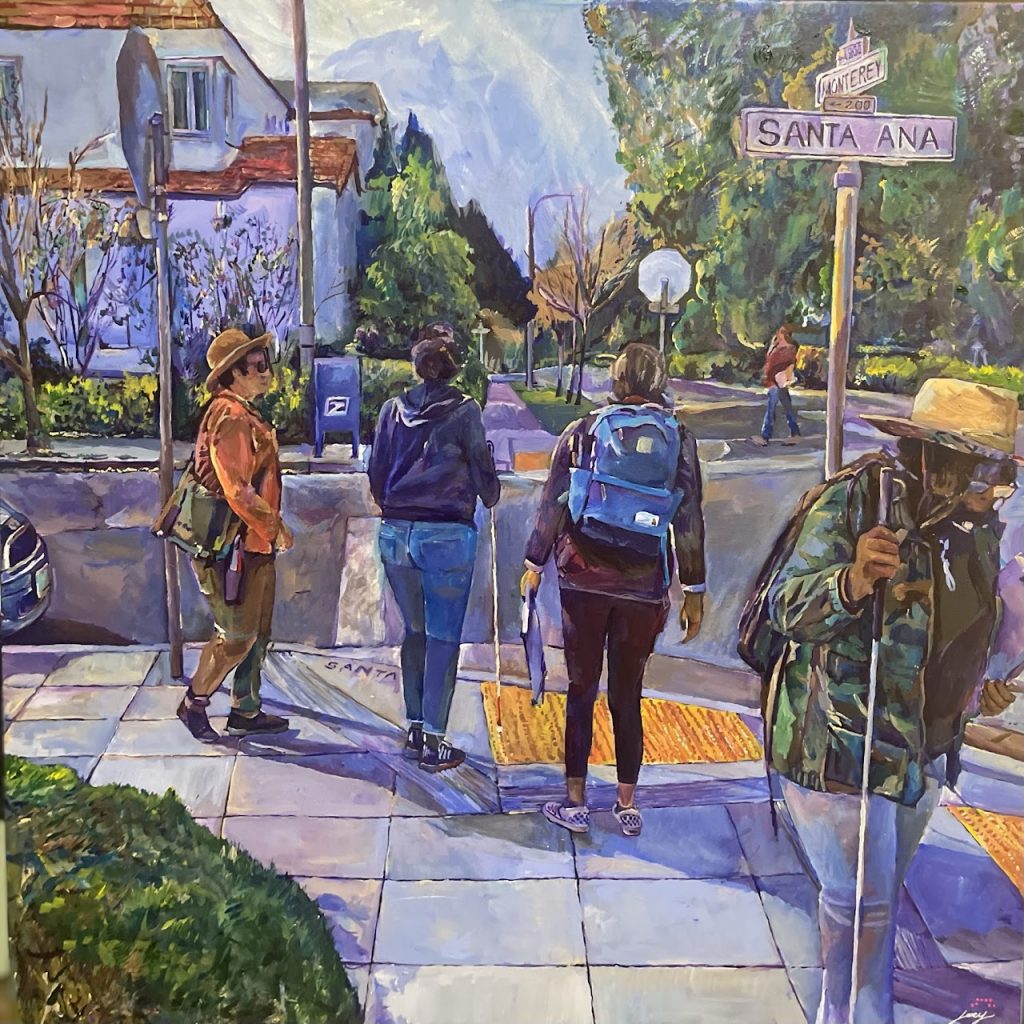
Image description: A painting of four figures standing at the corner of a sidewalk in a residential neighbourhood. The first is a man wearing a hat, sunglasses, and satchel. He carries a folded cane in a holster. The next two figures face the street. The second wears jeans and a hoodie. She holds a long white cane. The third wears a bright blue backpack with a cane tucked in a pocket. The fourth figure, a woman in a camo jacket and wide brimmed hat, is turned toward the viewer. She carries a white cane and clipboard . Her face is obscured by a lowered mask and glasses. Across the street, another figure talks on the phone while holding a clipboard. Signature reading “Joey” under pink sim braille of the initials “jch” in the lower right corner.
Joey quickly fell in love with painting and has been creating stunning works of art ever since. She often incorporates neon colours and blurred faces into her pieces to represent this aspect of her identity and is proud to show the world what it means to create art with a unique perspective. Through her work, she hopes to change the narrative about who can create and enjoy art.
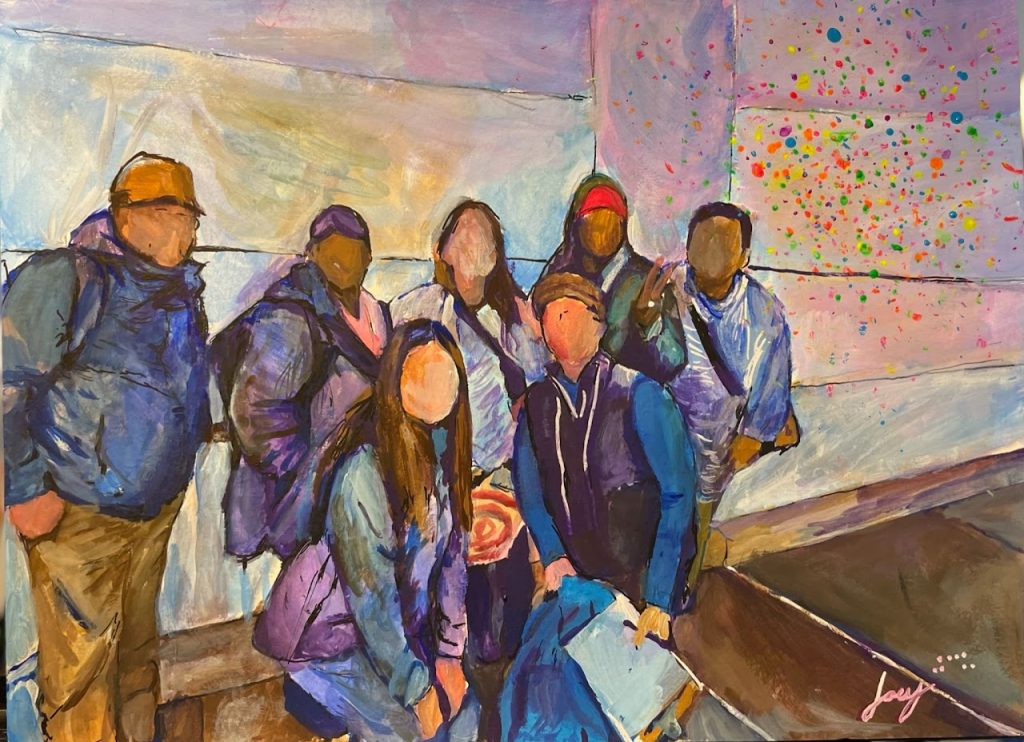
Image description:A group of people wearing rain gear stand together posing for a photo. The group wears various assortments of hats, ponchos, and bags. One of the two figures in the front holds a blue jacket and a clipboard. The brush strokes are loose. Sketchy black lines appear over parts of the painting. The faces of the seven figures are blurred, but turned toward the viewer. Neon dots cover the upper right field of the painting. Joey’s signature with sim braille reading “jch” in lower right corner.
‘Figuring out what adaptive strategies work best for me was and still is a trial-and-error process’ Joey says. She tends to work with larger canvases and sketchbooks, enabling her to create incredible detail. Using an adjustable easel, she can prop up her paintings and move them to her preferred viewing distance of about three to four inches from her face. She labels her paint tubes with tactile stickers and takes reference photos on her phone which she can zoom in on. Trays and paint palettes with plastic divots allow her to stay organized. Joey recommends that young artists keep exploring different tools and strategies until they find techniques that work.
‘My biggest piece of advice for young visually impaired artists is to have fun and experiment with their art supplies.’ – Joey Hernandez
Joey’s work has been featured in several shows, including the international APH InSights Art competition. When she’s not creating art, Joey enjoys skateboarding with her white cane and hanging out with her cat, Eevee.
Artist Profile – Laura O’Reilly
Laura O’Reilly (@visuallyimpairedartistlaura) is a multitalented visually impaired acrylic artist and crafter.
Based in Northern Ireland, Laura creates from both life and her imagination. ‘With less than 10% vision, I make things up!’ she says. Her paintings reflect her unique perspective on the world, showcasing a range of vibrant colours, intricate detail, and social commentary. Laura uses her skills to demonstrate that having a visual impairment doesn’t have to limit your potential or creativity. Her work is a testament to the power of imagination and determination.
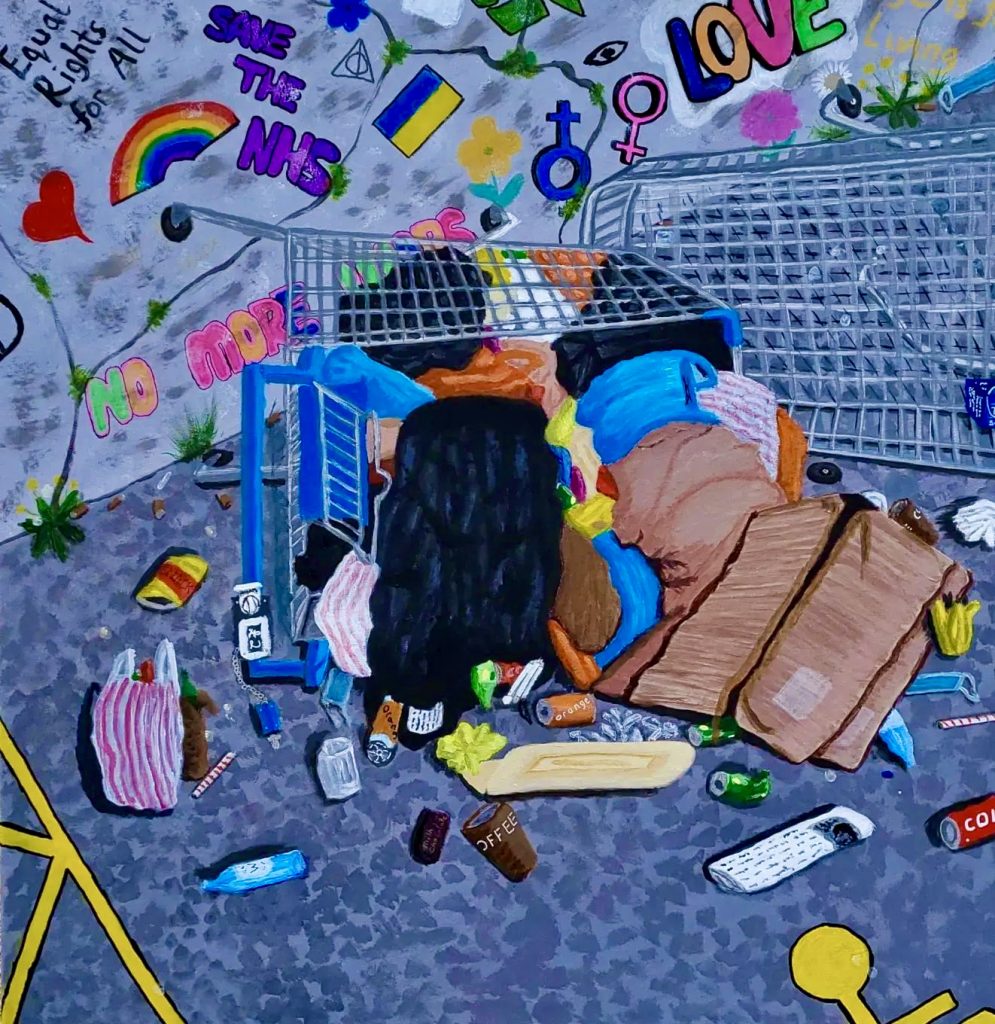
Image Description: Painting of two shopping trolleys tipped over spilling what appears to be a homeless person’s belongings across the floor, surrounded by rubbish, including cans, food waste, and facemasks, in front of a graffitied wall which reads ‘save the nhs’, ‘love’, and ‘equal rights for all’
‘As for advice, try everything at least once’ she tells Useful Vision. ‘Ask for and take all of the help that is available.’
Laura emphasizes the importance of exploring new things, seeking guidance, and building on past experiences in pursuing creative endeavours, particularly for individuals with visual impairments. ‘My parents sent me on an art and craft workshop when I was 7 or 8 and I still use the things that I learned then today.’ Laura encourages visually impaired children to be open-minded and willing to experiment with different strategies to find what works best for them.
‘You will find your own way of doing things, not just with art but in everything.’ – Laura O’Reilly
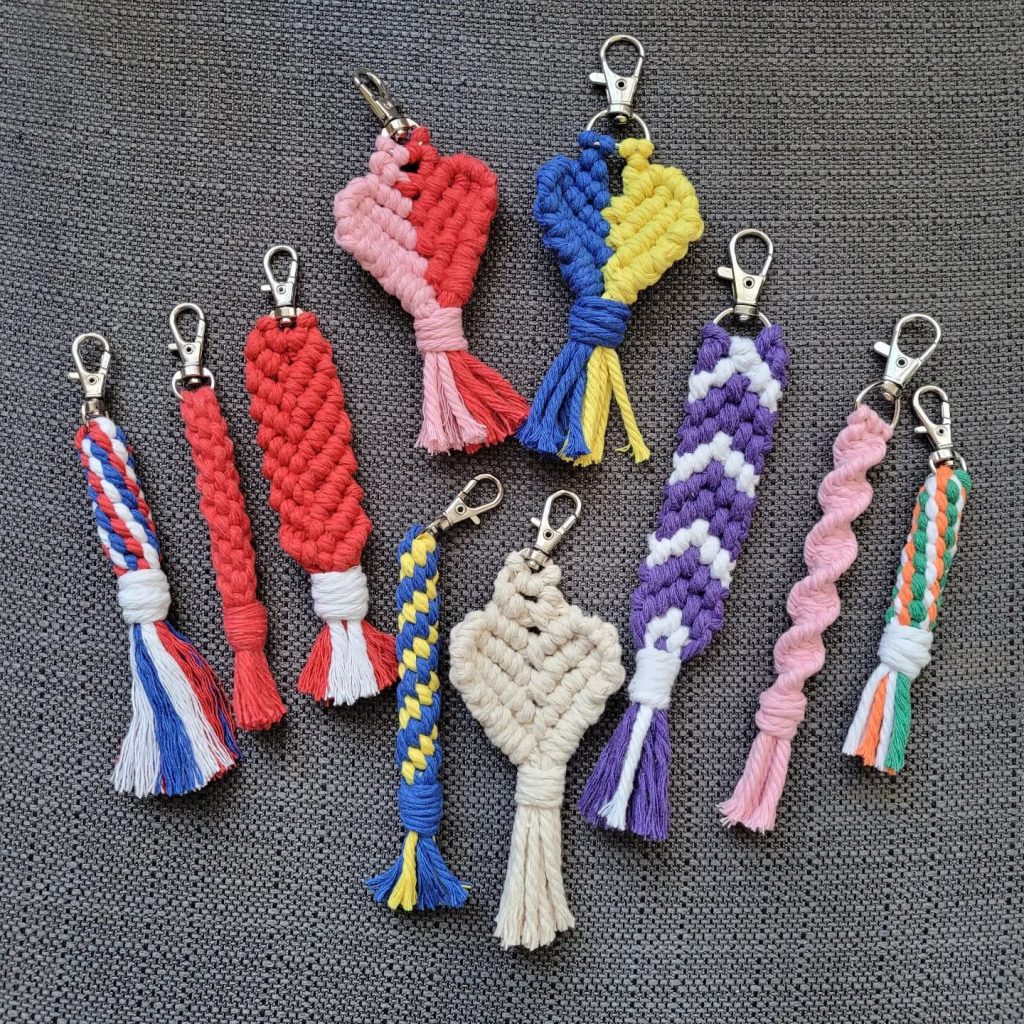
Image Description: A selection of handwoven keychains designed by Laura O’Reilly, available for sale in support of the Red Cross Appeal in Ukraine
Laura’s work has been featured in art shows across Scotland and Northern Ireland. She is currently raising money to support people affected by the war in Ukraine by selling macrame key rings and bag charms for £5 each. Highly customisable, you can choose your own colours and style and all proceeds will go the Red Cross Ukraine Appeal. Email Laura visuallyimpairedartist@hotmail.com or send her a message on Instagram to order.
Guest Feature – Kimberley Burrows
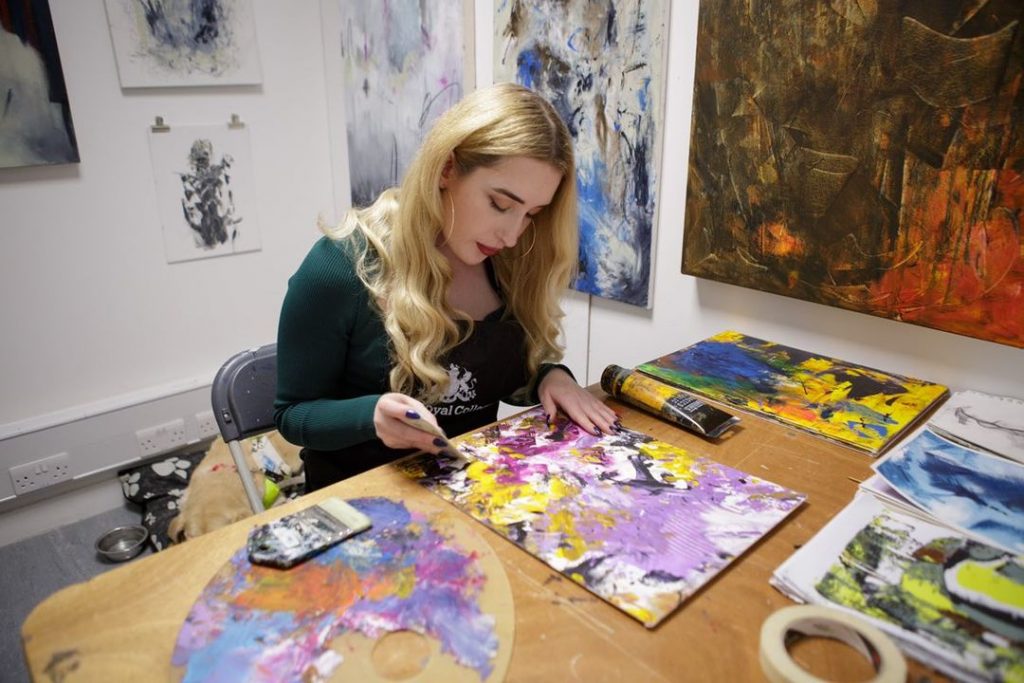
Image Description: A photo of Kimberley Burrows, a woman with long blonde wavy hair, sitting at a desk in her studio working on a painting
‘Hello! I’m Kimberley Burrows and I’m a blind artist and painter at the Royal College of Art in London, where I study a Masters degree in painting. Understanding my lived experience of blindness forms the biggest part of my painting practice.
I was born with cataracts that weren’t noticed until I was 4 years old. This meant I couldn’t see very well in my earlier years. Everything was blurry and I often had accidents. I spent a good part of my childhood at Great Ormond Street Children’s Hospital, in London, far away from my home in Greater Manchester. I had many operations to give me a little bit of useful vision in my left eye.
During my time at the hospital, feeling scared, lonely and sore, I found myself gravitating towards the art materials that were on my ward or in the play room. Crayons, pencils, paints, glitter sticks… I used it all. The various colours, textures, and smells distracted me, comforted me, enticed my senses and provided me with a space to make sense of complicated things I didn’t quite understand at the time. My love of drawing and painting began here and continued throughout primary school and high school.
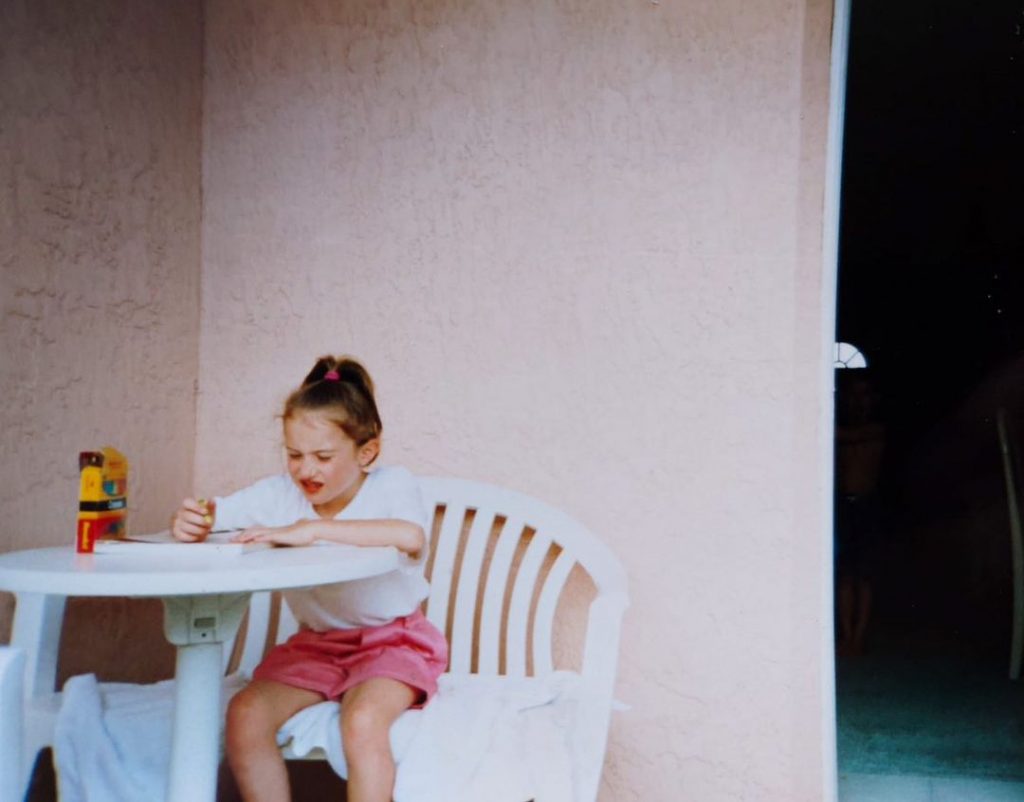
Image Description: A photo of Kimberley as a child sitting at a table and drawing
Art felt like something I had control over in circumstances where I didn’t have much control. I could determine what I learned and felt a sense of independence and achievement.
As a young adult, I met my favourite author who I wrote to often, Paddington Bear’s Michael Bond. I was kindly invited to his home where I gifted him my drawings of Paddington. He gave me some very wise words and set me on the path I’m still on today. I will share this with you, too! He told me to keep pursuing my dreams and to push them as far as they will go. As far as advice goes, this was some of the best I’ve ever been given!
After training with my Guide Dog, Tami, I felt confident enough to apply to art college. I was accepted into Leeds College of Art where I studied for a year and progressed to Leeds Arts University to study illustration. It was my dream to be a children’s book illustrator and make my own books just like Paddington Bear. I wanted to share with other children the joy that picture books gave me.
However, in my second year at university, both of my retinas detached and I lost all of my useful vision. I could no longer see to draw.
It took me years to grieve and to adapt. Even though I kept trying at university, I had a really difficult time. I turned to painting in my final year. This gave me an outlet to put my feelings onto a canvas without having to worry about anything figurative. My paintings are made with intention, care, and pure emotion. I finally graduated from university.
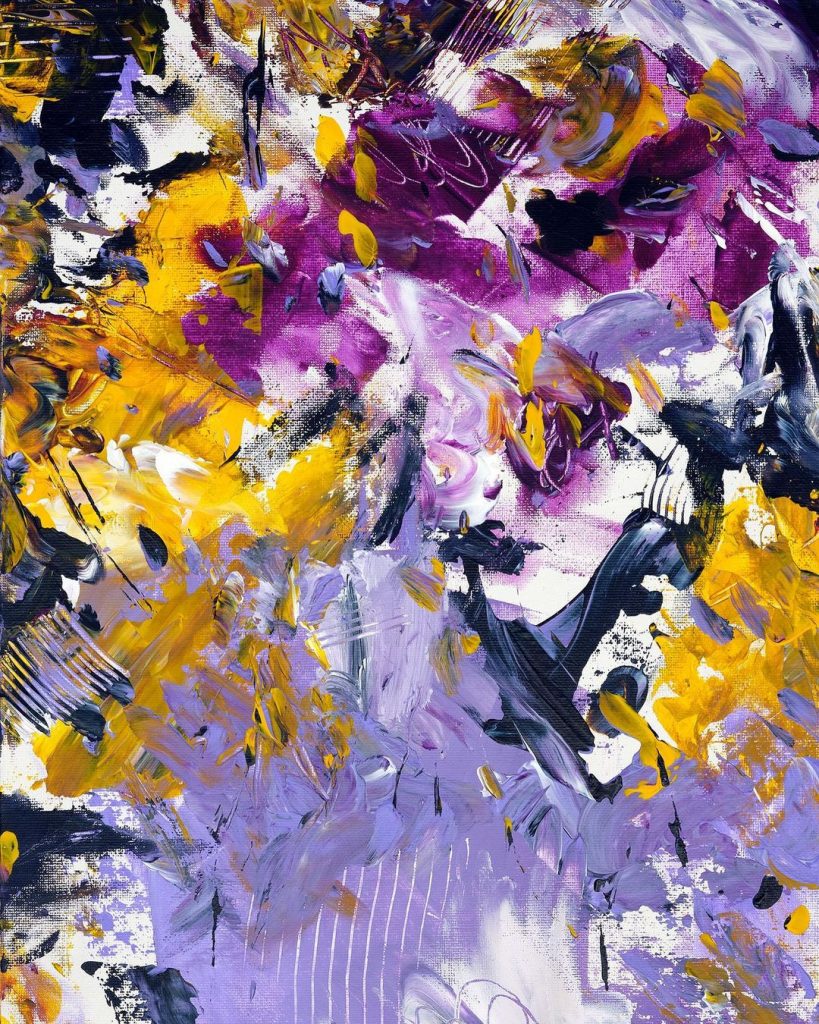
Image Description: An abstract expressionist painting, in landscape orientation, with ribbons and billows of purple, yellow, black, and white. Textured layers form with scratches to give depth and dimension.
A well-known clothing company reached out to me and turned these paintings into beautiful dresses! It felt like a celebration of my inner-strength and persistence through blindness and during the pandemic while I finished my degree.
I’m now studying my Masters degree in painting at the Royal College of Art, where I will have my first exhibitions across London, and where I will become the Student President once I graduate.
Painting brings me happiness but it is also very challenging. The challenge is what keeps painting exciting and rewarding. There are not many blind artists in the world. I feel unique and empowered by my experiences which have made me a stronger and more empathetic person. I have a valuable story to tell through materials.
And so do you!
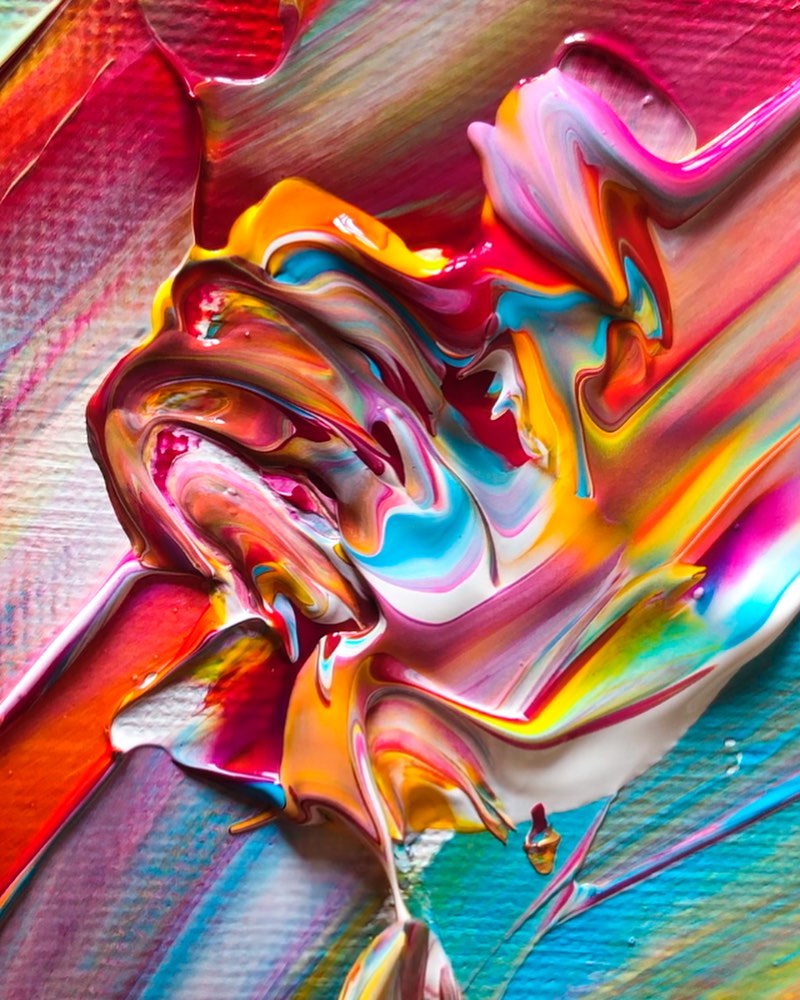
Image description: A small cross-section of an abstract expressionist painting. Bands of bright neon paint spread across the canvas in pink, yellow, blue and white. A swirl of acrylic paint sits in the centre in a squiggled application.
Here are my top tips for starting on your own creative journey:
-
Start by building up an art box. You can fill your box with things like crayons, coloured pencils, chalks, modelling clay, glitter pens and stamps.
-
Try as many new things as you possibly can from your box. Experiment to find what you like using on different surfaces and papers.
-
If it helps, label your materials using large print labels, a voice labeller, or a braille labeller. Apps on a smartphone such as KNFB Reader or Seeing AI can detect print labels and read them aloud. Get an adult to help you if needed.
-
You can use an easel or a desk which can lift the artwork and bring it closer to you.
-
Lighting is important if you have some useful vision. Using a Daylight Lamp will illuminate your artwork and you can alter the settings to make the light comfortable
-
Experiment with subject matter. If you have some useful vision, try drawing portraits of your family and friends or an arrangement of flowers or fruits for still life. These make nice gifts, too!
-
If you have no useful vision, like me, channel your creativity from within. How do you feel? What can you hear? How can you translate this into gesture and mark-making? I like to listen to music and paint along to the songs, translating what I hear and how it makes me feel. This is a form of abstract art.
-
Inspiration comes from everywhere!
-
Joining an Art Club at school is a great place to start learning the basics!
-
Learn about different artists, art movements and materials on YouTube. I spent many afternoons as a child watching an old TV show called Watercolour Challenge. It inspired me to paint with watercolours for the first time! I also loved Art Attack and Bob Ross’ The Joy of Painting.
-
Visit art galleries with your family. Many galleries have audio described tours which can be booked ahead of your visit, as well as accessible labels and materials.
-
Draw with your friends. Draw on location in a park on a sunny day to explore all of your senses!
Art is an enjoyable activity and skills will come over time, so practice often and have fun!
You can find me on Instagram at @KimberleyBurrowsArt and soon at kimberleyburrows.com’
Conclusion
The stories of these talented artists prove that creativity has no bounds. Being visually impaired doesn’t stop you from becoming an artist, in fact, experiencing the world in a different way can be a source of inspiration for creating incredible artwork.
Joey Hernandez, Laura O’Reilly, and Kimberley Burrows have all discovered their own techniques and strategies for creating art, and they want to inspire you to explore your creativity too. With determination, curiosity, and adaptive strategies, anyone can pursue their passion for art. Remember that there are no limits to what you can achieve – let these inspiring artists be your guide!
Useful Vision would like to thank all of the artists who took part for their insightful contributions.